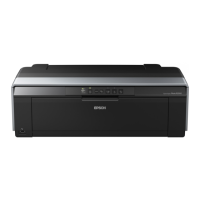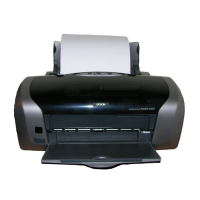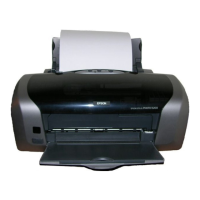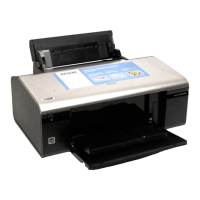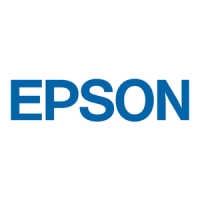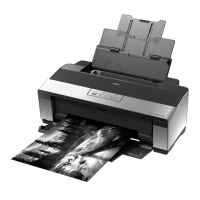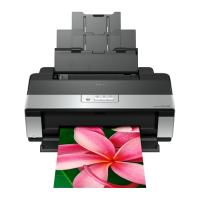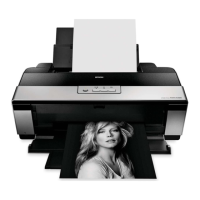Why is my Epson Stylus Photo R2000s saying 'Ink-out'?
- MMichelle PattersonAug 16, 2025
The Epson Printer displays 'Ink-out' because the cartridge has run out of ink. Replace the cartridge with a new one.
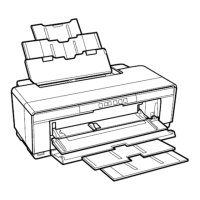
Why is my Epson Stylus Photo R2000s saying 'Ink-out'?
The Epson Printer displays 'Ink-out' because the cartridge has run out of ink. Replace the cartridge with a new one.
What to do if my Epson Stylus Photo R2000s Printer says 'Paper jam'?
If your Epson Printer indicates a paper jam, here's what to do: * If printing on paper, remove the jammed paper and press the Paper button. * If printing on CDR, remove the jammed CDR tray and press the Paper button.
What to do if Epson Stylus Photo R2000s Printer shows 'No paper' error?
If your Epson Printer displays a 'No paper' error, it means it failed to feed paper. Load paper correctly and press the Paper button.
What to do if Epson Stylus Photo R2000s has 'Paper path error'?
If your Epson Printer shows a 'Paper path error', it means the paper was loaded in a different way from the specified one. Eject the fed paper and press the Paper button after loading paper in the specified way.
How to fix fatal error on Epson Stylus Photo R2000s?
If your Epson Printer shows a fatal error, it indicates a mechanical error has occurred. Turn the power off and then back on.
What to do if my Epson Stylus Photo R2000s Printer displays 'No ink cartridge'?
If your Epson Printer shows a 'No ink cartridge' error, it means the ink cartridge(s) was not detected. Replace the cartridge with a new one.
What to do if my Epson Stylus Photo R2000s Printer displays 'Wrong ink cartridge'?
If your Epson Printer displays 'Wrong ink cartridge', it means incorrect ink cartridge(s) was detected. Replace the cartridge with the correct one.
Why does my Epson Stylus Photo R2000s say 'Cover open error'?
There are two possible reasons for the 'Cover open error' on your Epson Printer: * Printing was executed with the Printer Cover open. Close the Printer Cover. * The black ink cartridge was replaced during printing. Replace the cartridge with the one used before the error.
What is 'Multi-feed' error on Epson Stylus Photo R2000s and how to resolve it?
The 'Multi-feed' error on your Epson Printer means that multiple sheets of paper were fed at the same time. Press the Paper button to eject the multiple sheets.
What causes a 'CDR guide error' on an Epson Stylus Photo R2000s?
A 'CDR guide error' on your Epson Printer can occur due to two reasons: * The CDR Tray Base was open when receiving or printing an ASF print job. Close the CDR Tray Base. * The CDR Tray Base was closed when receiving or printing a CDR print job. Open the CDR Tray Base.
| Color Output | Color |
|---|---|
| Number of Ink Cartridges | 8 |
| Number of colours | 8 |
| Print Method | Inkjet |
| Print Resolution | 5760 x 1440 dpi |
| Maximum Paper Size | A3+ |
| Connectivity | Ethernet |
| Ink Type | Epson UltraChrome Hi-Gloss 2 |
| Operating Systems Supported | Windows, Mac OS X |
| Nozzle Configuration | 180 Nozzles per Color |
| Paper Formats | A3, A4, Letter, Legal |
| Product dimensions | 622 x 324 x 219 mm (Width x Depth x Height) |
| Product weight | 12.3 kg |
| Ink Colors | Cyan, Magenta, Yellow, Orange |
| Paper Handling | A3+ |
| Dimensions (W x D x H) | 622 x 324 x 219 mm |
| Weight | 12.3 kg |
Contains copyright, disclaimer, and notice regarding manual usage.
Details safety precautions, including DANGER and WARNING statements.
Provides an overview of the manual's purpose and structure.
Lists all revisions made to the manual with dates and descriptions.
Provides a general overview of the printer's capabilities.
Highlights the main features of the EPSON Stylus Photo R1900/R2880/R2000/R2000s.
Details the printing capabilities and specifications of the printer.
Covers fundamental printing specifications like print method and resolution.
Lists product numbers and specifications for EPSON ink cartridges.
Details various print modes available for different media types.
Lists supported paper types and sizes for different regions.
Specifies the printable area and margins for standard and borderless prints.
Describes the printer's USB interface specifications.
Covers general specifications including electrical and environmental conditions.
Details the primary power input and power consumption specifications.
Specifies operating and storage temperature and humidity requirements.
Provides information on the total print life and printhead durability.
Details the acoustic noise levels during printer operation.
Lists safety approvals and EMI standards compliance for various regions.
Describes the function of each operation button and LED indicator.
Details the function of the four main operation buttons on the printer.
Lists the eleven indicators (LEDs) and their meanings.
Provides detailed information on the functions of operation buttons and LEDs.
Lists common errors, their causes, and recommended remedies.
Introduces the chapter's focus on mechanical and electrical operating principles.
Explains the printer's mechanism, including motors and their applications.
Details the specifications and nozzle arrangement of the F-Mach printhead.
Describes the Auto PG setting for paper feed accuracy based on paper type.
Lists and describes the various motors and sensors used in the printer mechanism.
Introduces the chapter's focus on unit-level troubleshooting.
Provides a guide to troubleshooting printer errors based on LED and STM3 indications.
Details troubleshooting procedures for print quality issues and abnormal noise.
Provides an overview of disassembly and assembly procedures.
Details essential precautions before starting disassembly and reassembly.
Lists recommended tools for disassembly, reassembly, and adjustment.
Lists the types of screws used in the product for disassembly.
Describes how to make a special tool for CSIC board removal.
Provides a checklist to confirm proper service completion.
Explains the procedure for locking/unlocking the carriage and operating the CDR tray.
Presents a flowchart of step-by-step disassembly procedures.
Details the steps for removing various housing components of the printer.
Step-by-step instructions for removing the Paper Support Assembly.
Step-by-step instructions for removing the Stacker Assembly.
Instructions for removing the front decoration plates.
Instructions for removing the rear housing of the printer.
Steps for removing the printer's panel unit.
Instructions for removing the decoration plates on the left and right sides.
Detailed steps for removing the upper housing or printer cover.
Instructions for removing the upper housing support assembly.
Details the procedures for removing various boards from the printer.
Instructions for removing the main and power supply boards.
Steps for removing the LED board assembly.
Procedure for removing the high voltage module and its cover.
Provides steps for disassembling the printer's mechanical components.
Detailed steps for removing the APG Assy.
Instructions for removing the CR Scale component.
Step-by-step guide for removing the printhead and CSIC assembly.
Procedure for removing the lower housing and printer mechanism.
Detailed steps for removing the carriage shaft and unit.
Instructions for removing the ASF (Auto Sheet Feeder) Assembly.
Steps for removing the front paper guide pads and protection.
Procedure for removing waste ink pads and tubes.
Instructions for removing the printer's feet.
Steps for removing the PictBridge holder assembly.
Procedure for removing the paper EJ frame, front cover, and CDR tray base.
Instructions for removing the CDR release lever sub assembly.
Detailed steps for removing the ink system unit.
Procedure for removing paper guides, rollers, and trays.
Instructions for removing the PF roller shaft assembly.
Steps for removing the release holder assembly.
Instructions for removing the FLAG release assembly.
Steps for removing the upper paper guide assemblies.
Details the procedure for removing printer motors.
Instructions for removing the CR motor.
Instructions for removing the PF motor.
Steps for removing the ASF motor.
Details the procedure for removing various printer sensors.
Instructions for removing the CR encoder sensor board.
Steps for removing the PF encoder sensor holder.
Instructions for removing the ink mark and PW sensors.
Steps for removing the CDR sensor.
Instructions for removing the PE sensor holder.
Steps for removing the cover open sensor.
Provides an overview of adjustments required after part replacement.
Lists adjustment items, their purposes, and method outlines.
Lists the specific tools required for printer adjustments.
Explains adjustments not requiring the Adjustment Program.
Details how to adjust PF belt tension for paper feed accuracy.
Provides the specific method for PF belt tension adjustment.
Describes how to adjust PG for print head-to-paper clearance.
Provides the detailed method for PG adjustment.
Explains adjusting PF roller shaft support for paper feed.
Provides detailed steps for adjusting PF roller shaft center support.
Details the process for colorimetric calibration to ensure consistent color quality.
Explains the purpose and principle of colorimetric calibration.
Provides the workflow and steps for performing colorimetric calibration.
Describes adjusting ASF guide roller LDs for paper feed accuracy.
Provides detailed steps for adjusting ASF guide roller LDs position.
Provides information to maintain the printer in optimal condition.
Details procedures for cleaning the printer's exterior and interior parts.
Provides actions for clearing errors like print irregularity or maintenance errors.
Explains how to perform the built-in head cleaning function.
Describes the maintenance request error related to waste ink pad saturation.
Specifies the type, amount, and location of grease for printer components.
Provides detailed steps for lubricating the carriage shaft.
Shows the connections between the main printer components.
Refers to Service Parts Information for exploded diagrams and parts lists.
Describes specifications and functions unique to the R2000/R2000s series.
Details features unique to the Stylus Photo R2000/R2000s.
Provides dimensions and weight specifications for the printer casing.
Describes the wired and wireless LAN connection interfaces.
Specifies the ink cartridge product numbers and handling guidelines.
Details the nozzle configuration for black and color inks.
Explains the ink scrambling sequence executed by the CR moving.
Describes the operation buttons and LED indicators on the printer.
Lists common errors and their corresponding remedies for the R2000/R2000s series.
Details fatal errors and their associated remedies for the printer.
Describes changed and new parts specific to the R2000/R2000s series.
Provides a summary of disassembly procedures for specific parts.
Presents a flowchart of step-by-step disassembly procedures.
Instructions for removing the Panel FFC Cover.
Steps for removing the printer's panel unit.
Instructions for removing the decoration plates on the left and right sides.
Detailed steps for removing the upper housing or printer cover.
Instructions for removing the wireless LAN board assembly.
Instructions for removing the main and power supply boards.
Details adjustment items and procedures specific to the R2000/R2000s.
Provides a summary of new and changed adjustment items.
Lists adjustment items, purposes, and methods for R2000/R2000s.
Details specific adjustment procedures for the R2000/R2000s.
Explains the procedure for setting the MAC address after replacement.
Describes the process for colorimetric calibration specific to this model.
Details the multi-sensor adjustment procedure for the ink mark sensor.
Describes specifications and functions unique to the SC-P400 Series.
Details features unique to the SC-P400 Series.
Highlights differences in servicing between SC-P400 and R2000/R2000s.
Describes the external appearance and design differences.
Specifies the ink cartridge product numbers for the SC-P400 Series.
Describes the operation buttons and LED indicators for the SC-P400 Series.
Lists common errors and their remedies for the SC-P400 Series.
Details fatal errors and their associated remedies for the SC-P400 Series.
Describes changed and new parts specific to the SC-P400 Series.
Provides a summary of disassembly procedures for SC-P400 Series.
Presents a flowchart of step-by-step disassembly procedures for SC-P400.
Instructions for removing the wireless LAN board assembly.
Refers to Chapter 4 for board disassembly; describes connector layout.
Details adjustment items specific to the SC-P400 Series.
Provides an overview of adjustment items for the SC-P400 Series.
Lists adjustment items, purposes, and methods for SC-P400 Series.
Details specific adjustment procedures for the SC-P400 Series.
Describes the colorimetric calibration procedure for SC-P400 Series.
Provides access to the printer's maintenance functions.
